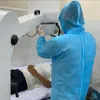New guidelines on COVID-19 diagnosis, treatment issued

The new guidelines will replace of the old ones issued on February 20.
Most COVID-19 fatalities are among the elderly, and people with immunodeficiency or chronic diseases. The incubation period is between 2 to 14 days (5-7 days on average). Common symptoms are a fever, dry cough, fatigue and muscle aches. Some cases include a sore throat, stuffy nose, runny nose or headache, cough with phlegm, vomiting and diarrhea. The average time from the initial symptoms to the severe course of the illness is usually about 7-8 days.
Most people (about 80 percent) only have a mild fever, cough, fatigue, and no pneumonia, and recover on their own in about a week. About 14 percent of cases with severe developments such as pneumonia need hospitalization. About 5 percent of cases need to be treated in intensive care units with symptoms of acute respiratory failure, septic shock, and organ failure, including kidney and heart muscle damage that lead to death.
In children, the clinical manifestations are much milder than adults. Their common symptoms are fever and a cough or pneumonia manifestations. The rate of serious illnesses in children is less than in adults.
Patients after treatment will be discharged from hospital if the fever goes away for at least three days, clinical symptoms improve well, survival signs are stable, blood tests are normal, and chest X-rays improve. Especially, they must test negative for SARS-CoV-2 at least twice within 24 hours. After leaving hospital, the patients will continue to be quarantined at home for 14 days and take their body temperature twice a day.
The new guidelines have many new points. The definition of a suspected case has been altered because the epidemiological situation has changed, and there are many epidemic areas and outbreaks in Vietnam. The definition of a possible case has been removed as testing capacity in the country is higher than before.
In terms of treatment, the main focus is on respiratory failure with updates on the latest recommendations from the World Health Organization on oxygen therapy and blood oxygen targets.
The guidelines stress the importance of the close monitoring of patients, especially on the 7th to 10th day of the disease, to promptly detect and handle serious progression.
For patients with severe respiratory distress, incubation and mechanical ventilation should be used early. Non-invasive respiratory support measures should be considered for each specific case.
Regarding specific antiviral drugs such as Lopinavir/Ritonavir, Chloroquine, Hydroxychloroquine and Remdesivir, the Health Ministry does not recommend using them as there is insufficient evidence on their effectiveness and safety. The ministry will issue additional recommendations based on the results of studies in the world and in Vietnam.





